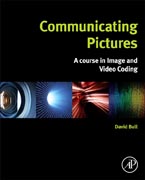
Communicating Pictures provides a unique perspective of the role of images in communications, drawing on the author's extensive experience of teaching and consulting in signal processing and video coding. The book covers the basics of video communications and includes a strong grounding in image and video perception, combining algorithmic rigour with practical methods for implementation - for example in boundary extension and complexity reduction for wavelet filterbanks, and fast algorithms for implementing transforms and motion estimators. With this book you will learn: . How to exploit redundancy to reduce bitrate and improve rate distortion performance . The pitfalls associated with the transmission of real-time video over networks (wireless and fixed) . The conflicts between conventional video compression, based on variable length coding and spatio-temporal prediction, and the requirements for error resilient transmission . How packet and bit errors influence a codec and how to mitigate their impact through packetization strategies, cross layer optimisation, resilient entropy coding, pyramid vector quantisation (fixed length codewords), and through the addition of source and channel coding redundancy . How to use the state of the art video coding standard (H.264/AVC) as a basis for algorithm development and explanation in the context of block based compression . About future video coding standards such as the new ISO/ITU High Efficiency Video Coding (HEVC) initiative, as well as parametric and region-based compression methods. Covers the basics of video communications and includes a strong grounding in how we perceive images and video, and how we can exploit redundancy to reduce bitrate and improve rate distortion performance. . Companion website features a Matlab based learning aid, facilitating an easier understanding of image and video compression methods and implementation . Gives deep insight into the pitfalls associated with the transmission of real-time video over networks (wireless and fixed) . Uses the state-of- the- art video coding standard (H.264/AVC) as a basis for algorithm development in the context of block based compression . Insight into future video coding standards such as the new ISO/ITU High Efficiency Video Coding (HEVC) initiative, which extends and generalizes the H.264/AVC approach. . Gives examples of parametric and region-based compression methods that currently offer world-beating performance and which are strong candidates for future standards. INDICE: Introduction; Basic Concepts: Visual Information; Digital Representation of Images and Video; Information Theory; Transforms for Image and Video Coding; Lossless Compression Methods; Coding Moving Pictures: Motion Estimation; Filterbank Methods: Sub-Band and Wavelet Compression; Measuring and Managing the Quality of Compressed Pictures; Communicating Pictures: Delivering Images Across Networks; Video Coding Standards
- ISBN: 978-0-12-405906-1
- Editorial: Academic Press
- Encuadernacion: Cartoné
- Páginas: 550
- Fecha Publicación: 01/10/2014
- Nº Volúmenes: 1
- Idioma: Inglés
